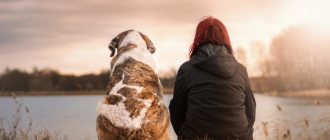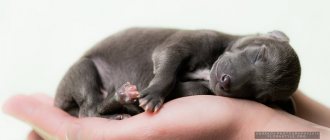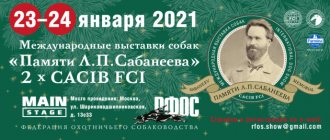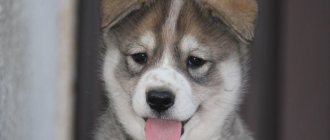History of the Yakut Laika breed
Initially, the breed had more than twenty names, since every researcher who came across Yakut Laikas gave them a new name.
Accordingly, if you come across references in the literature to such varieties as the Yukaghir, Arctic, Evenk, Tunguska and Okhotsk Laika, keep in mind that we are talking about the same dog. The homeland of these intelligent and active creatures is the North-East of Russia, or more precisely, the environs of Omolon, Anadyr, Kolyma, Yana, Indigirka and Bolshoi Anyui. Historically, animals lived near the so-called dog rivers - large waterways rich in fish. The reason for the limited breeding range of the breed is explained by practicality. The indigenous peoples of Siberia fed their pets exclusively with dried gifts from reservoirs, and therefore acquired huskies where it was possible to feed them. Archaeological excavations show that hunting with dogs in the Republic of Sakha began more than 8,000 years ago, which is additional confirmation of the aboriginal status of the breed.
Among Yakut hunters of the 16th century, a husky was considered an incredible value, and its puppy was considered an expensive gift, obliging a lot. Adults were not given or exchanged, since the dog was the main breadwinner and means of transport for the family. In addition, the northerners sincerely believed that huskies had supernatural powers and were able to see spirits.
The first descriptions of the breed were made by famous pioneers - Semyon Dezhnev, Ivan Rebrov and Ilya Perfilyev. As for reliable images, they were provided by the Dutch cartographer Nicolaas Witsen. He also wrote a book about his travels around Russia, in which he told that in Siberian villages huskies are used not just as breadwinners and watchmen, but also as cheap draft power. It is also known that during the expedition of Vitus Bering, Yakut huskies carried the explorer’s equipment and food supplies, and in the 19th century the dogs were used to deliver mail to remote areas of the North.
The first preliminary breed standard is considered to be the description compiled by Maria Dmitrieva-Sulimova in 1910. At the same time, Yakut huskies did not appear at exhibitions until the beginning of the 21st century. Only after the approval of the official RKF standard in 2005, “Yakuts” began to be exhibited in the rings. However, even today the number of animals remains small, which is due to the planned extermination of dogs in the 50s of the 20th century. Then the Soviet leadership recognized the breeding of the breed as inappropriate, so during mass shootings the main part of the Laika breeding stock was eliminated.
Krasnoyarsk
One of the first kennels seriously involved in sledding sports was the kennel of Tatyana Vishnyakova from Krasnoyarsk “IN YAN BIYCHEM”.
In 2015, a team of 5 dogs took 2nd place at a distance of 85 km! OVERALL! Some more results:
2014 - team 4 dogs 10 km 41:02:02 - 2nd place.
2015 – 5 dog team 10 km. 56:01:78 - 4th place
2016 – 4 dog team 10 km. 53:20:03 - 4th place
2016 — dryland kart 6 dogs 5 km. 18:59 - 1st place
2017 – 4 dog team 10 km. 42:08:37 — 3rd place
Tatiana's son began competing at the age of 5, in 2015 he drove a team for the first time, and in 2022 he took 2nd place with a team of 2 dogs at the age of 7!
In Krasnoyarsk, Dmitry Gordienko has success, who participated in canicross with young dogs together with Olympian Zeus (14 months owner Irina Rodnina) in the “Golden Siberia 2017” dryland and won 1st place in tough competition with huskies and pointers.
Yakut Laika breed standard
The constitution of the animals was shaped by the extreme climatic conditions of the North, the effect of which was enhanced by the working status of the breed, so you definitely shouldn’t expect refined forms from Yakut huskies. The correct “Yakut” today is a compact, robust breed with very thick skin and incredibly developed hair, which lacks any hint of looseness and dampness in build. But the expression of the sexual type, on the contrary, is inherent in the breed, so males are always wider in the chest and larger than females.
“Girls” have their own distinctive feature - a stretched body, which is due to the ability to bear and give birth to offspring. The height of an adult Yakut husky male is 55-59 cm, female - 53-57 cm. Deviations from the specified growth parameters are undesirable due to the historical purpose of the animals. Dogs that were too small always ran out of steam faster while riding and were unable to overcome large snow drifts, while dogs that were too large broke through the crust with their weight and sank in the snow.
Head
The head is large, slightly pointed, wedge-shaped. The skull of the “Yakut” is more rounded than that of other varieties of huskies, but less massive than that of the Samoyed. Distinctive characteristics of the head are a high forehead, a well-filled but moderately short muzzle, and not too prominent cheekbones.
Nose
The rather large lobe has wide, well-opened nostrils. The classic color of nose skin is black. Brown color is allowed only in individuals of white-brown and brown-white color. Partial depigmentation of the nose, often found in white-headed dogs, is undesirable, but is not considered a defect. An important nuance: in some Yakut huskies, complete coloring of the earlobes and eyelids is completed only by 1.5 years.
Jaws, teeth, lips
The jaws are very wide. The teeth are massive, in full number (42 units). A bite can be straight or scissor, and huskies over three years old are allowed to have a tight bite. In breeding, preference is always given to dogs with scissor jaws. The lips are dry, clearly pigmented, tightly bordering the animal's mouth.
Eyes
The eyes are set wide and straight. The shape of the eyelid incision is almond-oval. The colors of the iris are dark brown, transparent blue, and brown with blue specks. Heterochromia (different eyes) is considered a relevant feature.
Ears
The symmetrically located ears are distinguished by a triangular shape and a high set. The ear pad is moderately thick, semi-erect or erect (the second option is more desirable). A moving dog's ears tend to fold back.
Neck
Muscular, has medium length and the same set. The neck should connect smoothly to the withers; any kinks at the junction are unacceptable.
Frame
The body is compact, developed, without a bias towards squareness. The top is straight, with a slightly pronounced line of inclination running from the withers to the beginning of the tail. The back of the Yakut Laika is distinguished by its solidity and width; the short, strong loin plays the role of a flexible spring when moving. Mandatory condition: the length of the lower back must be at least ½ the length of the back. The croup is not excessively sloping, almost horizontal, massive and long. The chest is round in cross-section with good sprouting of the ribs.
Limbs
Mandatory conditions for the front legs of the Yakut Laika are parallelism, moderately wide stance, and even contours. The shoulder blades and humerus are the same length. The elbows are well pressed to the sides, the pasterns are strong and short.
For the hind legs, a strengthened skeleton, a parallel position and a normal (not wide or narrow) stance are important. The thighs should have voluminous muscle mass, the angles of the knee joints should not exceed 115-120°. The shins are at an angle of 45-50°, the metatarsus are vertical and strong. The paws of Yakut huskies are oval-type, with half-bent toes in a ball, hard pads and thick hair between the toes. The breed moves at an energetic trot or gallop.
Tail
Fluffy, high-set, rolled into a semi-circular structure and thrown over the top of the back. The tail drops and hangs down only during a long run or in a resting dog.
Wool
The spine is smooth, hard, shiny and has a very voluminous warm undercoat. Feathers are formed on the back of the legs, an elongated spine is formed on the underside of the tail, and an abundant collar is formed around the neck, most pronounced in males. The desired length of the coat of the Yakut Laika: on the body - up to 5 cm, on the dewlap of the tail and mane - up to 15 cm. The complete formation of the structure of the coat is completed only by two years.
Color
Representatives of the breed are born completely white or spotted (any two- or three-color variations). Like the structure of the awn, the colors of Yakut huskies stabilize over the course of two years.
Disqualifying faults
- All solid colors except white.
- Addition disproportions.
- Overshot with a large distance between the incisors, underbite, skewed jaw.
- Depigmented skin of the nose, lips, eyelids.
- Smooth wool.
- Angry or cowardly behavior in the ring.
- Males that resemble the graceful build of females, and vice versa.
Character of the Yakut Laika
The Yakut Laika is a smart dog, focused on constant interaction with the owner and members of his family. The level of aggression in the breed is minimal, so feel free to bring the “Yakut” into a house where there are small children - this four-legged fidget will certainly make friends with them. By the way, the sociability of Yakut Laikas extends not only to people: in a group of their own kind, the nimble “northerners” also do not shy away and quickly find contact with all members of the group.
In working circumstances (hunting, riding), the breed is quite independent and capable of making its own decisions. Do not confuse this character trait with stubbornness: it is not typical for animals to act contrary to a person’s order, therefore the dog’s personal initiative manifests itself only where the owner’s prohibitions cease to apply. The Yakut Laika is not a breed for a passive owner. To truly experience life, a dog must work. And it doesn’t matter so much whether it’s moose hunting, skijoring or sled walking. Having not given their all physically, the “Yakut” gets bored, falling into apathy, or vice versa – demonstrating destructive behavior.
Most sources describing the characteristics of the breed focus on the docile nature of its representatives. In this regard, potential owners have a not entirely correct impression of Yakut huskies as obedient and naturally intelligent pets. In fact, the “northerners” are capable of destructive cunning tricks, and if they are not stopped in this, they can go far in their sabotage. At the same time, the breed remains extremely intelligent and quickly draws conclusions from any situation, which greatly facilitates the educational process.
Pereslavl-Zalessky Yaroslavl region
The young athlete Veronika Kalinina is confidently gaining momentum, from whom we expect amazing results, judging by the growth dynamics of her sporting achievements:
“Faster than the Wind” 2014 – bikejoring 1 dog – 2nd place
In the Footsteps of Yellow Leaves 2016 - Scooter 1 dog - 2nd place.
In the Footsteps of Yellow Leaves 2022 – Kart 4 dogs – 3rd place
Spirit of Freedom 2022 – team 4 dogs 10 km – 2nd place
Call of the Ancestors 2022 – Kart 4 dogs – 1st place
Education and training
It cannot be said that Yakut Laikas are so dominant in character, although they need a leader in the person of their owner. Remember, a dog listens only to those whom it respects and whose authority it is ready to recognize. Yakut Laikas have excellent eyesight, sense of smell and hearing - invaluable innate qualities if you are going to raise a hunter from a puppy, but you should not expect superpowers from your pet. In Siberia, “Yakuts” were bred as “everything dogs,” so hunting was more of an additional qualification for the breed than a lifelong pursuit. Today, Yakut huskies are used mainly to hunt elk and bear, but for fur hunting they are not considered the most suitable helpers.
Raising a husky puppy begins with socialization. In the first days after moving to a new place of residence, the baby gets used to the changed conditions, smells and people in his environment. During this period, the animal needs to be helped to get used to it - to limit its movement area as much as possible (preferably to one room) and not create stressful situations during contact. Toilet training of the Yakut Laika should begin as early as possible. Usually the puppy is placed on the tray immediately after sleep and rest. If you initially plan to relieve yourself outside, take your pet out into the yard more often.
Owners who decide to keep a puppy in yard conditions from the first days of life should not neglect hygienic discipline either. Usually, yard dogs themselves find a favorite place on the territory, which they use as a toilet. If your ward gets into the habit of leaving “heaps” wherever the need arises, try to adjust his habits. For example, spray areas you want to keep clean with a strong-smelling deodorant or a menthol scent that dogs hate. Another option is to place piles of earth marked with other “tails” in the area of the proposed toilet. Laikas are excellent smellers, so when they find such a “hello” from their fellow tribesmen, they will definitely want to leave their odorous mark on it.
Training should begin at 2-3 months. By this point, the Yakut Laika puppy should know his name and respond to the nickname. The first commands to be worked out are: “Come to me!”, “Sit!”, “Place!” and “You can’t!” It is better to conduct classes twice a day so that the animal does not get bored with them. If you are raising a future show star, then after the command “Sit!” teach your pet to obey the demand “Show your teeth!” – breeding commissions approach the assessment of occlusion strictly.
With six-month-old individuals, it is recommended to practice the orders “Near!” and “Look!” – without them you won’t be able to control your pet’s behavior while hunting. It is also advisable to learn the commands “Lie down!”, “Wait!”, “Fetch!”, “Give.” Moreover, you can give orders not only with your voice, but also with gestures - in hunting conditions, when the animal is very close, the dog’s ability to read the owner’s gestures will serve a good purpose. You can get more detailed information about hunting training methods and training methods in the books “The Laika and Its Training” by V. Belousov, as well as the article by A. Maksimov “Raising Laikas”. And of course, do not forget about the golden rules of the trainer: do not repeat the command more than three times and always reward the puppy for the slightest achievements.
Owners who remember the breed's riding purpose and harness a husky to a sled should also follow a number of rules. Namely: do not harness a dog that is under one year old. Remember also that in the North, sleds are pulled by at least 8 dogs, so even an ordinary sled with a child sitting in it is an unbearable load for one animal. The distribution of places in the sled is also carried out in a strict order: the strongest dogs are placed closer to the sleds, and those with leadership abilities are placed in front.
Recently, dog sled racing has been gaining popularity in Russia, so it makes sense to hang out on social networks and find a professional musher who gives lessons to beginners - these can be found not only in Siberia, but also in the Middle Zone. It is also useful to visit “Volga Quest” - the International sledding husky race, held in Russia, where professional mushers and simply those who like to ride the breeze compete. Just remember: the dogs that will pull your sleds must be friends. Antagonists in the same team would rather squabble than agree to work together.
Novosibirsk
The EL FLAUM nursery (Anna Pukhova) holds the championship in races and competitions. It is impossible to list all her achievements in a short review, we can only summarize: from 2013 to 2016, the kennel participated in CEC 1 (that is, together with Siberian Huskies), taking fifth and sixth places (about 10 races), in canicross Anna won 2 and 3 places, in dryland 6 dogs (karts) took 3rd place. The last two years the results are just as impressive: 6 dogs (sledge) 4th place CEC 1 in two races, as well as CEC2 - 6 dogs (sledge) 1, 2, 3 places in three races.
Competition “Power of Siberia-2018” - Anna’s team took part in a 165 km race. and took 1st place CEC-2!
Anna Pukhova-Filimonova took 1st place SES 2 in the START RACE 2018 Kemerovo race (6 dog team, 6.2 km.) Congratulations to our champion!
Anna Uskova from Novosibirsk herself takes part in competitions with pleasure and introduced her son Artemy, who, in addition to participating in races, also wins as a young handler. Anna repeatedly took first place with a team of 2 dogs.
Maintenance and care
The Yakut Laika is not well adapted to urban realities, much less to life in an apartment. The natural environment for a dog is a country estate with a large walking area or an ordinary rural farmstead. Having a thick coat, animals tolerate cold weather more easily than tropical heat, so it is not advisable to take them out for walks and hunting on especially hot days. The optimal living conditions for “Yakuts” are a yard and an enclosure. Keeping a husky in the house is also possible, but it involves a number of inconveniences for both the pet and the owner.
Hygiene
It is clear that Siberian hunters had no time to deal with the image of working dogs, so today’s Yakut huskies are undemanding in terms of care, and they do not necessarily need to be taken to grooming salons. The breed sheds seasonally, and the hair of huskies does not emit a strong dog smell. In principle, it is not advisable to bathe “northerners”, since their “fur coats” are capable of self-cleaning, but it is necessary to give your pet a bath a couple of times a year. You will have to tinker more with exhibition specimens, and in this case, costs for professional cosmetics cannot be avoided. Particular attention will have to be paid to white huskies - they need shampoos and conditioners designed specifically for “blond” dogs.
A washed Yakut Laika can be dried with a hairdryer or compressor - the hair structure does not suffer from this. During the shedding period, the dog will have to be brushed daily to prevent the loose undercoat from matting. The rest of the time, you can brush your pet sporadically – once a week or less.
Even a child can master eye care for the Yakut Laika. It is enough to moisten a clean cloth in hygienic ophthalmic lotion or strong tea infusion and wipe the edges of the eyelids, removing dust and mucous lumps from them. Ear cleaning is carried out once a week according to the same principle: we buy lotion for the hygiene of the ear funnel and use a clean cloth to remove excess wax. Nail trimming is mandatory for huskies that walk little and unproductively; claws need to be shortened with a nail clipper for medium-sized breeds about once a month.
Feeding
The ancestors of the Yakut huskies were not spoiled with pickles - in winter the dog was fed dried fish so that it had the strength to pull the sled, and in the summer, during a period of relative inactivity, they were treated to slops and leftovers. Today there is no point in following northern traditions, so most breeders feed their pupils either high-quality “dried” or natural products. At the same time, the “seasonality” of the diet should be observed if the animal lives in a yard or enclosure: in winter, feed more densely (80% of the diet is meat protein), in summer - less calorie.
The diet of modern Yakut huskies is raw or lightly cooked lean meat (rabbit, chicken, lamb, horse meat, turkey), tripe, any offal, sea fish with bones previously removed, cereal porridge cooked in bone or meat broth. Not all dogs digest fermented milk products, so they can only be given to dogs for whom this food does not cause digestive upset. Vegetables and fruits, except potatoes and legumes, are only beneficial for huskies. Moreover, they should be given dried or raw - cut into thin slices, as well as shaved. Cabbage and other cruciferous vegetables are best served boiled.
Chicken egg yolk, unrefined vegetable oil, fish oil, kelp, tendons and spongy flat bones are fortified supplements to the basic diet, without which the puppy’s development will slow down. You should also not refuse to buy pharmaceutical dietary supplements with chondroitin and glucosamine, but only if the dog has a natural menu. Some hunters advise lightly adding salt to dog food, but this matter must be approached with extreme caution. It is also useful to arrange fasting days 3-4 times a month, when the husky drinks only water and eats a small amount of rye crackers. The rest of the time, an adult dog is fed twice a day, puppies under one year of age - 4-5 times.
Health and diseases of Yakut Laikas
The indigenous status of the breed has endowed its representatives with excellent health and a predisposition to a limited number of diseases. The main ailments to which Yakut Laikas are susceptible are joint dysplasia, eye diseases (cataracts, glaucoma, retinal dystrophy, congenital complete or partial blindness), cancer problems in older dogs, dermatitis and eczema. Please note that the last two diseases manifest themselves mainly in individuals living in hot climates. Thick undercoat, which warms in northern latitudes, causes a lot of problems in southern regions because it prevents air circulation between layers of wool and slows down heat exchange processes.
How to choose a puppy
- Evaluate the puppy’s appearance in accordance with the breed standard, but do not forget that the structure of the coat and color of young animals are not formed. As a result, you will only be able to find out how intense the color and high-quality hair your pet will have by the age of two.
- Pay attention to the puppies' mobility and activity. Healthy Yakut Laika babies are little “electric brooms” who play and play pranks endlessly.
- For hunting purposes, you need to choose a puppy from working parents. Hunters usually recommend paying attention to babies born first and having a keen sense of smell. You can check the latter quality in the first month of life - the puppy that finds its mother's nipple first has the most outstanding sense of smell.
- Print out the Campbell test and test it on puppies at the kennel. With its help, you can identify a number of behavioral defects in children that are difficult to notice in everyday life.
- If you need a Yakut Laika with leadership abilities, choose the most curious and courageous puppy. One of the indicators is that the baby encroaches on his own mother’s bowl and even tries to eat from it.
Irkutsk
Rimma Demina from Irkutsk in 2013 took 1st place among women at a distance of 10 km. in skijoring with 2 dogs. Her son Ilya Demin achieved truly impressive results in skijoring! For 4 years he has held the championship at a distance of 10 km. skijoring with 2 dogs!
Ilya (20 years old) and Pavel Demin (55 years old) are the only ski athletes in our community who work at long distances. The distances they have overcome are amazing, their perseverance and willpower are inspiring. And, of course, wonderful heroes - the Yakut and East Siberian Laikas Aragorn and Burma, Akta and Pamir!
2014 90 km. — Ilya 1st place, Pavel 2nd place
2015 90 km. — Ilya 1st place, Pavel 2nd place
2016 155 km!!!! — Ilya 1st place! Pavel 56 km. 1 place







